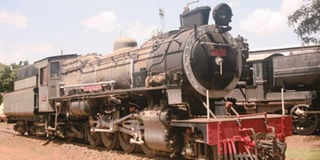Grand history of the lunatic express

PHOTO | FILE The 1923 locomotive at the Railways depot.
“Nairobi itself will in the course of the next two years become a large and flourishing place, and already there are many applications for sites of hotels, shops and houses ...”
So said, in 1898, a man called George Whitehouse, a man who had taken on the most challenging task of his life — or any man’s life for that matter — managing the building of the railway from Mombasa to Port Florence (now, of course, Kisumu) on Lake Victoria.
For the job, George Whitehouse had an imposing title: Uganda Railway Manager and Chief Engineer. Yes, it was first called the Uganda Railway; because the main reason for the British constructing it was to secure Kampala, frustrate French designs on Uganda, and have control of the headwaters of the Nile .... But that’s another story.
A by-product
Back to George Whitehouse’s statement. It reminds us that Nairobi actually owes its existence to the building of the railway — or, as Elspeth Huxley put it, “The capital was simply a by-product of the railway”.
These two quotations I have taken from a splendid book by Stephen Mills. Yes, he has done it again. Three years ago he produced Dreams, Schemes & Flying Machines. That was the story of a hundred years of flying in East Africa, 1909 to 2009.
His new book is the story of the railway. He calls it A Railway to Nowhere: the Building of the Lunatic Line, 1896-1901. I say “his” book, but Stephen Mills makes Brian Yonge his joint author.
Brian was, as Stephen calls him, a “seasoned railway man”. He worked for the East African Railways and Harbours, East African Railways and then Kenya Railways, as a surveyor from 1963 to 1980.
When he died in 1989, he left behind a very full but unpublished manuscript on the building of the railway. Stephen has adapted this, incorporated and embellished it with historical context, pen pictures of many characters and a gallery of superb photographs.
The title of the book echoes the very strong criticism of the Uganda Railway project made in the British Parliament by a very flamboyant politician with a very un-British name: Henry Du Pré Labouchère.
Back in 1896, when the funding of the railway was up for debate, Labouchère said: “The railway starts from nowhere and nobody wants to use it. It goes nowhere and nobody wants to come back by it ...”
Labouchère was also the man who wrote the verse, much quoted at the time:
What it will cost no words can express
What is its object no brain can suppose
Where it will start from no one can guess
Where it is going to nobody knows
What is the use of it none can conjecture
What is its object there’s none can define ...
It clearly is nought but a lunatic line.
Labouchère, of course, claims one of the insets in Stephen Mills book — a photograph and a brief biography.
There are many others: historic figures such as Mwanga 11, the Kabaka of Uganda, Sir William Mackinnon, founder of the Imperial British East African Company, Tippu Tip, the notorious slave and ivory trader from Zanzibar ...
There are the railway men, such as Sir George Whitehouse, the chief engineer, and Ronald Preston, the construction engineer in charge of plate laying — and the father of Vic Preston, the first winner of the Safari Rally.
It was Ronald Preston who described Mile 326 (Nairobi) as “a bleak swampy stretch of soppy landscape, windswept, devoid of human habitation of any sort, the resort of thousands of wild animals of every species”.
The photographs
The description of the construction works can be rather heavy going — like the building of the railway itself, I suppose. You have to be something of a railway buff or a bit of an engineer to fully appreciate it.
But the photographs showing the rail’s progress — mile by mile, bridge by bridge, station by station — they are fascinating. So this is the kind of book you will want to leave around for you and your visitors to have an occasional browse.
But A Railway to Nowhere is about more than a railway; it is also about the Where. It is well sprinkled with anecdotes and pictures of the peoples and landscapes of what became Kenya.
You can get the book at Bookstop in the Yaya Centre, at any other good bookshop in Kenya — or you can order it off the website www.millspublishing.com.
It costs Sh4,950. It will make a much appreciated present for anyone interested in the building of the railway — or the story of Kenya.
It inspired me to take the train last Sunday evening from Mombasa to Nairobi. That ambivalent story I will tell next week — and it is not as grand or as romantic as Stephen Mills’ story.
John Fox is Managing Director of iDC




